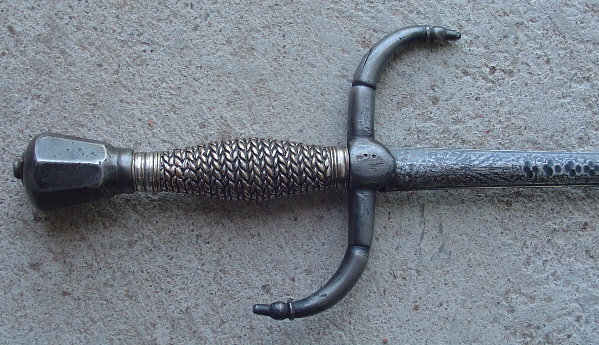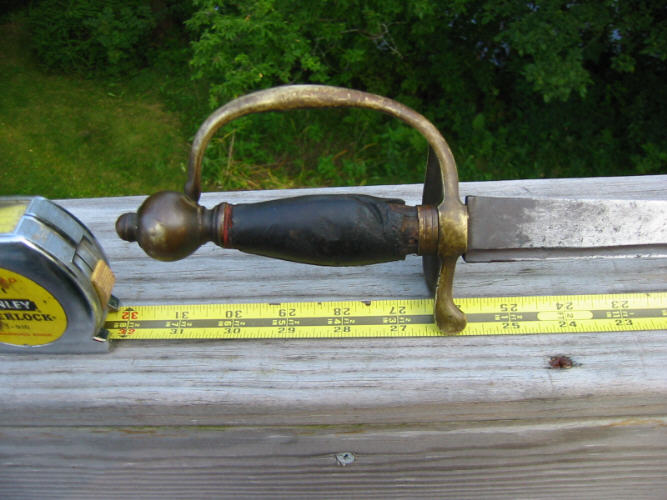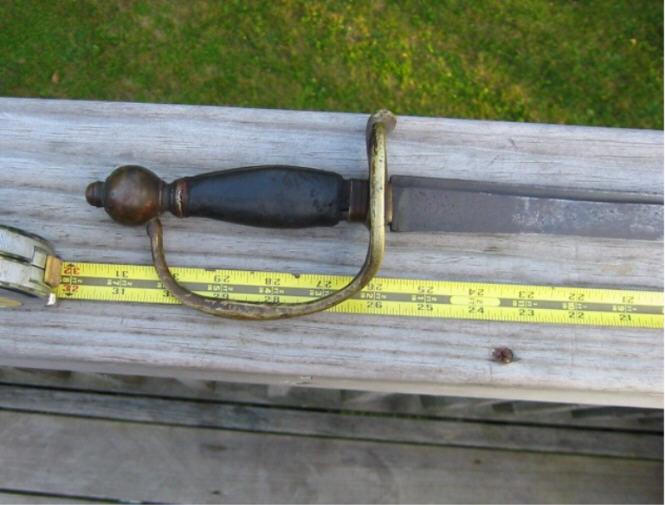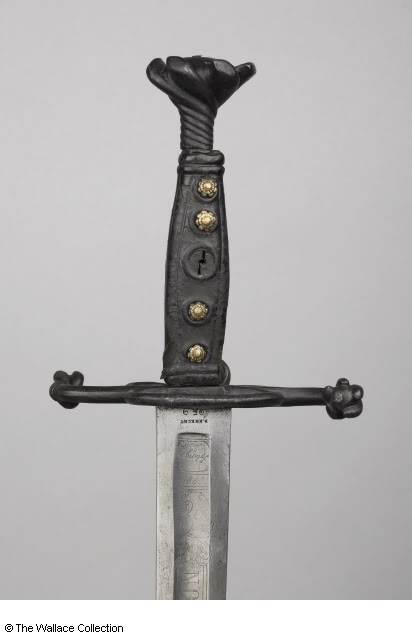I am wondering if there are examples of historical swords that are suspected to have older period hilt furniture fitted to newer blade forms. Having dabbled in forging and knife making a little bit, I would personally value the furniture (hilt and pommel pieces) as having roughly similar value to a blade. I believe that high quality examples of furniture should have been less prone to breakage than the blade, and would have been good candidates for fitting to newer blades if the "re-fitting" theory were valid.
Are there any archeological examples that might confirm this?
I believe it's generally held that the refitting would have been done the other way around, a good blade (lots of work to make) may well have been updated by fitting it to newer (more fashionable) mounts (Records of the Medieval Sword has an example).
Of course should a blade break there is a chance that it will be refitted to existing fittings (especially after the medieval period where screw-threaded components would make that trivial), but as there was a clear fashion for fittings i doubt you would see very old fittings re-used on a new blade (unless there is some reason to retain the old fittings like in the case of a relic).
2d
N.
Of course should a blade break there is a chance that it will be refitted to existing fittings (especially after the medieval period where screw-threaded components would make that trivial), but as there was a clear fashion for fittings i doubt you would see very old fittings re-used on a new blade (unless there is some reason to retain the old fittings like in the case of a relic).
2d
N.
Here are a couple of my collection that come to mind.
The cut down 18th century smallsword blade may well be an entirely recent compilation, as the pommel has machining marks and the tang had a threaded section scarfed and brazed on to secure things. The grip cast and hollow, although may have been from the 19th century. The guard, another I can't really place in time exactly.
The other, a cast steel blade possibly of Pettibone's American patents from the early 19th century, while the guard and pommel as early as the mid 18th century. This one was done well and of apparently blade period work. While it may also have been originally assembled like this from parts, the join of blade shoulder and guard don't quite jive as being the original intent.
We also see other military efforts when the mixes may reflect a family blade refitted from generation to generation. This is also seen with Japanese blades, some centuries old being refitted time and again.
Cheers
GC
 Attachment: 102.05 KB
Attachment: 102.05 KB

 Attachment: 219.29 KB
Attachment: 219.29 KB

 Attachment: 79.32 KB
Attachment: 79.32 KB

 Attachment: 64.16 KB
Attachment: 64.16 KB

 Attachment: 55.17 KB
Attachment: 55.17 KB

The cut down 18th century smallsword blade may well be an entirely recent compilation, as the pommel has machining marks and the tang had a threaded section scarfed and brazed on to secure things. The grip cast and hollow, although may have been from the 19th century. The guard, another I can't really place in time exactly.
The other, a cast steel blade possibly of Pettibone's American patents from the early 19th century, while the guard and pommel as early as the mid 18th century. This one was done well and of apparently blade period work. While it may also have been originally assembled like this from parts, the join of blade shoulder and guard don't quite jive as being the original intent.
We also see other military efforts when the mixes may reflect a family blade refitted from generation to generation. This is also seen with Japanese blades, some centuries old being refitted time and again.
Cheers
GC





| Nathan Beal wrote: |
| I believe it's generally held that the refitting would have been done the other way around, a good blade (lots of work to make) . |
This is the point I was trying to get across. In many cases, the furniture was also a lot of effort to make. At present, I see little reason other than "period fashion", why blades would have been recycled more often than furniture.
There's a rapier in the Army museum in Stockholm which has a hilt estimated to be ca 1620, while the blade is dated 1652. Maybe more of a working life repair or so though, given the (relatively) short timespan between the two.
I'm attaching a picture of it, and you can also see it at http://www.sfhm.se/templates/pages/ArmeObject...anguage=EN
 Attachment: 32.22 KB
Attachment: 32.22 KB
[ Download ]
I'm attaching a picture of it, and you can also see it at http://www.sfhm.se/templates/pages/ArmeObject...anguage=EN
[ Download ]
Last edited by Kjell Magnusson on Mon 10 May, 2010 7:19 am; edited 1 time in total
| Kjell Magnusson wrote: |
|
I'm attaching a picture of it. |
Sincerely,
Thank you for sharing that Kjell.
I don't study rapiers, but am aware that some blade forms resembled earlier broad swords. That seems like an interesting example, worthy of some type of a post subject on its own merit.
Hello,
I am sure there are examples of re-fit hilts... as almost everything was recycled. However I would not expect this to be particularly common, due to few issues.
We must remember that in the medieval period materials where expensive, labour was cheap. Even if hilts and blades were equally difficult to make... a blade uses more material and thus is more valuable.
Secondly, during most of the period blades and hilts were not made by the same person. Generally one would bring a finished blade to a cutler to have fittings made. Or in some periods a cutler would simply buy blades fit them and re-sell them as finished swords.
Thirdly, the expertise needed to forge, grind, and heat treat sword blades is highly specialized. Pretty much any jeweler or metalworker would have the capacity to fabricate hilt components.
In conclusion, my belief is that a hilt would be so much cheaper than a blade (for the above reasons) that it wouldn't make sense to go through the trouble of having a blade made to fit an old hilt. If a blade was broken it would end up being re-made into something else (shears, knives, etc...)... and so the hilt most likely was as well; I just don't see it being re-used as a hilt (you would need a blade specially made to fit the hilt). In the Viking period we have examples of few damaged swords being converted into weaving swords, thus retaining their hilts.
Cheers,
Hadrian
I am sure there are examples of re-fit hilts... as almost everything was recycled. However I would not expect this to be particularly common, due to few issues.
We must remember that in the medieval period materials where expensive, labour was cheap. Even if hilts and blades were equally difficult to make... a blade uses more material and thus is more valuable.
Secondly, during most of the period blades and hilts were not made by the same person. Generally one would bring a finished blade to a cutler to have fittings made. Or in some periods a cutler would simply buy blades fit them and re-sell them as finished swords.
Thirdly, the expertise needed to forge, grind, and heat treat sword blades is highly specialized. Pretty much any jeweler or metalworker would have the capacity to fabricate hilt components.
In conclusion, my belief is that a hilt would be so much cheaper than a blade (for the above reasons) that it wouldn't make sense to go through the trouble of having a blade made to fit an old hilt. If a blade was broken it would end up being re-made into something else (shears, knives, etc...)... and so the hilt most likely was as well; I just don't see it being re-used as a hilt (you would need a blade specially made to fit the hilt). In the Viking period we have examples of few damaged swords being converted into weaving swords, thus retaining their hilts.
Cheers,
Hadrian
| Hadrian Coffin wrote: |
| ... a blade uses more material and thus is more valuable.
...... Thirdly, the expertise needed to forge, grind, and heat treat sword blades is highly specialized. Pretty much any jeweler or metalworker would have the capacity to fabricate hilt components. |
Thanks for the response Hadrian. I do agree with this for the most part.
On the other hand, I love the Merovingian gold and garnet cloisonne, Scandinavian art style inlay work, and similarly elaborately decorated furniture known primarily from burial treasures and river finds. I am assuming that this class of furniture, and possibly even scabbards, could have had higher value than the original blades themselves. In such a cases, several theories might explain what happened when blades were damaged; It might be completely disposed of, buried with a Royal class owner, passed on to successors, exhibited in some way for a time as a cultural treasure before being lost, or recycled? In central Europe Carolingian era, the burial tradition seems to have died out more rapidly than in Scandinavian regions and Anglo-Saxon Brittain. So, I am pondering possible examples of precious quality hilt forms that appear to be mismatched in terms of period blade types.
From the Wallace Collection:
Peter Knecht (born 1796)
Solingen, Germany
1530 - 1770
c. 1530 (hilt)
c. 1770 (blade)
A520

Peter Knecht (born 1796)
Solingen, Germany
1530 - 1770
c. 1530 (hilt)
c. 1770 (blade)
A520

Page 1 of 1
You cannot post new topics in this forumYou cannot reply to topics in this forum
You cannot edit your posts in this forum
You cannot delete your posts in this forum
You cannot vote in polls in this forum
You cannot attach files in this forum
You can download files in this forum
All contents © Copyright 2003-2006 myArmoury.com — All rights reserved
Discussion forums powered by phpBB © The phpBB Group
Switch to the Full-featured Version of the forum
Discussion forums powered by phpBB © The phpBB Group
Switch to the Full-featured Version of the forum